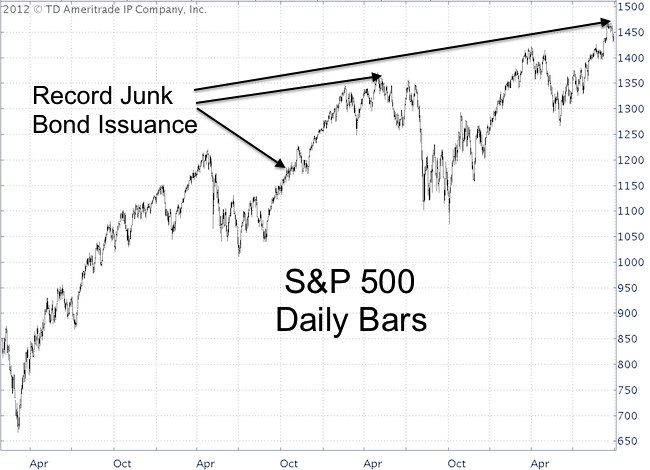All major U.S. stock indexes continue to trade near multi-year highs, but insiders are selling stocks of the companies they own or manage at a pace not seen at any other time in 2012.
Investors Intelligence reports eight sales for each purchase and considers the current rush for the exits “panic selling.” The question we should ask is, “what do insiders know that we don’t?”
Another sentiment extreme can be seen in the high yield bond market, more appropriately called junk bonds. Companies just issued the third-highest amount of junk bonds.
The prior records were set in October 2010 and May 2011. Those two dates are marked in the chart below. I’ll explain in a moment the significance of those two dates.

Mutual fund managers tracked by the National Association of Active Investment Managers report that managers have a median exposure of 95% to equities. This is close to a six-year high and sets an 18-month record.
The Dow Jones just went an entire quarter without losing more than 1%. Jason Goepfert with SentimenTrader took a look at what happens historically when the Dow goes an entire quarter without a 1% decline, while trading close to a 52-week high.
There were 16 such instances since 1900. Over the next six months, the Dow was positive every time with a median return of +6%.
Getting back to the two dates highlighted in the chart above, we are currently in a situation where sentiment is becoming extreme. But just as Advil covers up pain, QE3 tends to neutralize extreme optimism.
Back in October 2010 it took several months before sentiment extremes caught up with stock prices. In May 2011 however, it resulted in a nasty sell off.
From a seasonal perspective October is an interesting month. It has hosted a number of crashes but also a number of important lows.
Looking at stocks, we see that the S&P 500 (S&P 500 SPDR – SPY) has been trading in a well-defined parallel trend channel. The strategy - as long as the S&P remains within this channel – is to sell when it reaches the top of the channel and buy at the bottom.
Once the bottom (of the channel) falls out, it’s probably time to become more bearish.
The Profit Radar Report monitors literally dozens of sentiment gauges, seasonal patterns, and technical developments to identify high probability investment opportunities.
|